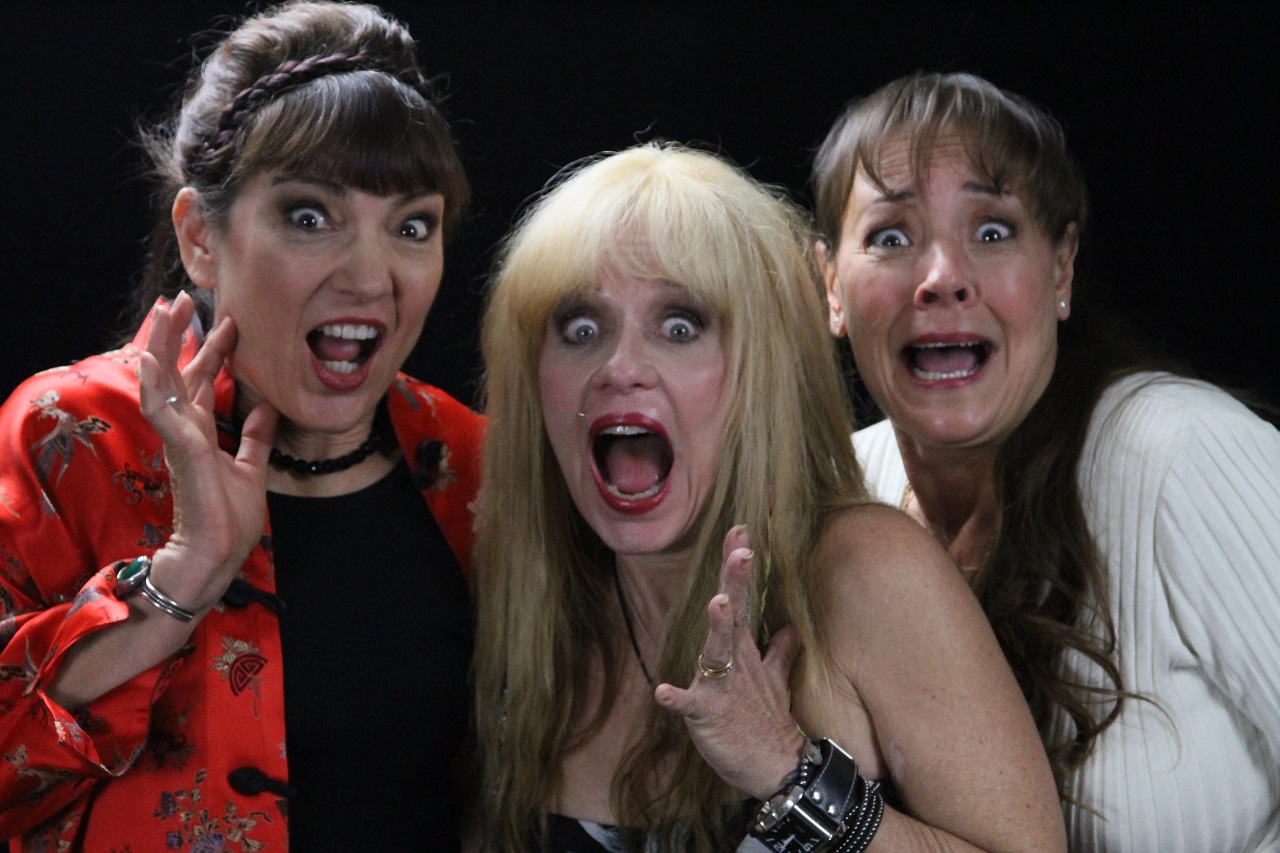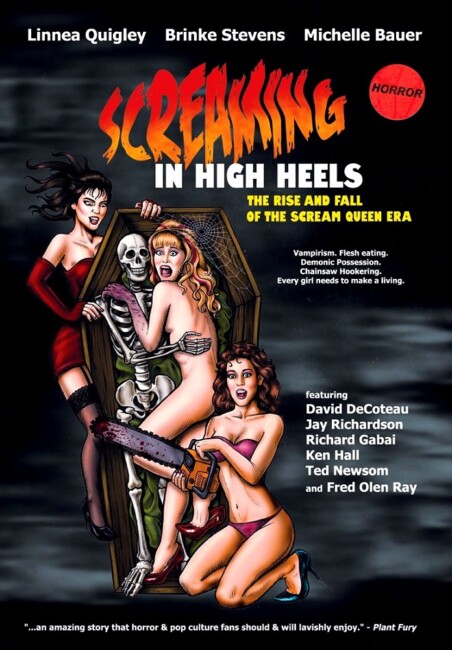Crew
Director/Screenplay/Producer – Jason Paul Collum, Photography – Anthony Masi & Justin Propp, Music – Paul Meyer. Production Company – B+Boy Productions.
Screaming in High Heels is a documentary that charts the so-called Scream Queen phenomenon that lasted from the mid-1980s to the mid-1990s. Scream Queens were a series of horror actresses – the principal three, Linnea Quigley, Brinke Stevens and Michelle Bauer, are profiled and interviewed here, although there were a number of others. The Scream Queens appeared in a series of cheaply-made horror films made for the video market where the principal selling point is that they would whip their clothes off at the drop of a hat. The films frequently came tongue-in-cheek and were centred around little more than goo effects, monsters and the Scream Queens alternately kicking ass and getting nekkid. Titles included classics like Creepozoids (1987), Slave Girls from Beyond Infinity (1987), Sorority Babes at the Slimeball Bowl-a-Rama (1987), Hollywood Chainsaw Hookers (1988), Nightmare Sisters (1988), Beverly Hills Vamp (1989), Bad Girls from Mars (1990) and Teenage Exorcist (1991), to name but a handful of the more notorious titles.
Director Jason Paul Collum is a clear fan of the genre, as soon becomes evident throughout the documentary. He has set out to chart the Scream Queen phenomenon and does a reasonable job. He brings together Linnea Quigley, Brinke Stevens and Michelle Bauer. They are perfectly candid and unashamed about what they did (excepting perhaps Bauer who tells how has now retired as a Scream Queen and no longer mentions what she used to do in polite company). They discuss their diverse beginnings – Quigley was the shy girl, Stevens set out to be a marine biologist but married a comic-book artist, Bauer was the weird girl in high school – and variously fell into the industry.
From their interviews, you get the impression that they were extremely hard working and in high demand – they have each appeared in over 100 films apiece. All the films were low-budgeted and often shot in around a week, sometimes less, where neither they nor the directors were under any impression they were creating art. The Scream Queen phenomenon soon gained them a substantial fan following on the convention circuit and they also discuss this.
The documentary also roots the Scream Queen in its historic time and place. It is seen as occurring simultaneously with the rise of the video store and the death of the drive-in theatre and so-called grindhouse screens. Directors and producers quickly churned films for the direct-to-video market on low-budgets that made a play for sensationalism. The death of the phenomenon is also speculated as being due to several reasons – the rise of chains like Blockbuster that would no longer carry certain titles; the advent of the home video camera that allowed almost anybody to be able to make a film for next to nothing; the popularity of the phenomenon seeing a host of other wannabes making claim to being Scream Queens and the market becoming flooded. In terms of the demise of the genre, what also comes through is that the three actresses were starting to hit their forties by the end of the 1990s where seeing them whip their clothes off no longer quite held the same appeal and there simply weren’t the plethora of roles for them anymore.

Screaming in High Heels does a good job of charting the Scream Queen phenomenon. However, it does come with some limitations. The number of interview subjects is narrow – Quigley, Bauer and Stevens, as well as Fred Olen Ray and David DeCoteau, the two directors who were most associated with the phenomenon. Outside of these, the interview subjects are limited. The film quickly dismisses other Scream Queens, although some of the names it does cite – Debbie Rochon, Julie Strain – perhaps had more prominence than it is willing to give them. Outside of these five core figures, the film seems to be straining to find people of relevance. There is Kenneth J. Hall, a writer and makeup effects artist who only directed Evil Spawn (1987) and Linnea Quigley’s Horror Workout (1990); Richard Gabai, a minor actor in several films and director of Assault of the Party Nerds (1989); and Ted Newsom, more known as a documentarian of the genre and whose sole directorial credit was as co-director of Evil Spawn. Other figures who had more crucial influence over the genre, such as producer Charles Band and director Jim Wynorski, are strangely absent.
That also brings one to Jason Paul Collum. Collum is clearly a fan of the Scream Queen genre and raised the money for Screaming in High Heels via a Kickstarter campaign. Alas, he also inserts himself as an interview subject. It may well be that he does so because he could not find anyone else with sufficient familiarity of the genre to speak knowledgeably. In that he comes across as an unattributed expert on the phenomenon without telling us that he is also the director of the film, the effect is to insert a sense of authorial self-importance into the documentary. It is sort of the equivalent of liking your own Facebook posts – nerdy and self-important. Nor does he mention that he is a former production coordinator on a number of DeCoteau’s films and has worked with several of the Scream Queens on his own films, which in legal speak is usually referred to as ‘conflict of interest’.
Jason Paul Collum has also made a number of other low-budget horror films with Mark of the Devil 666: The Moralist (1995), 5 Dark Souls (1996), 5 Dark Souls Part II: Roots of Evil (1998), October Moon (2005) and its sequel November Son (2008), which both featured Brinke Stevens, the non-genre Shy of Normal: Tales of New Life Experience (2011) and the horror films Safe Inside (2017) also featuring Stevens and Mark of the Devil 777: The Moralist, Part 2 (2022) with Stevens and Bauser, as well as the horror documentaries Something to Scream About (2003), a further work about Scream Queens, and Sleepless Nights: Revisiting the Slumber Party Massacres (2010).


